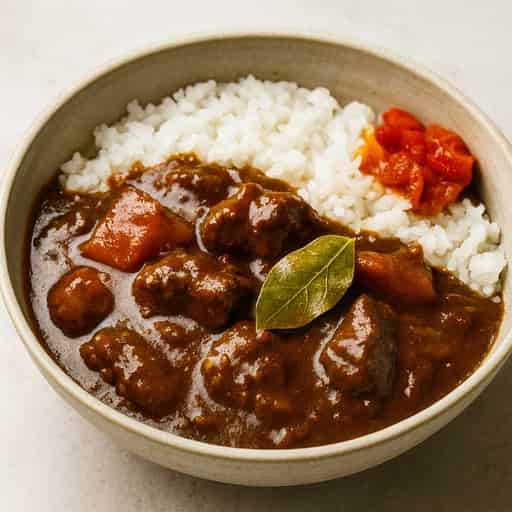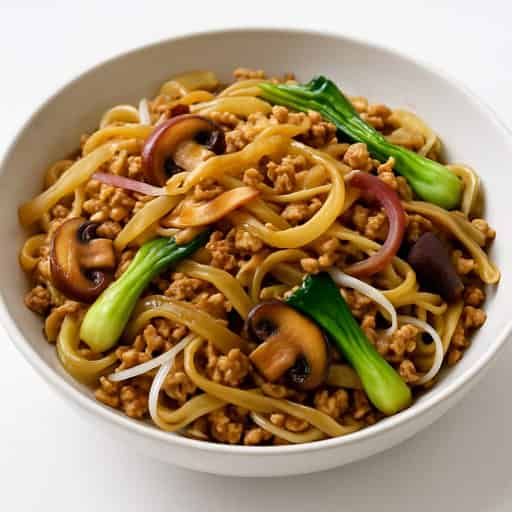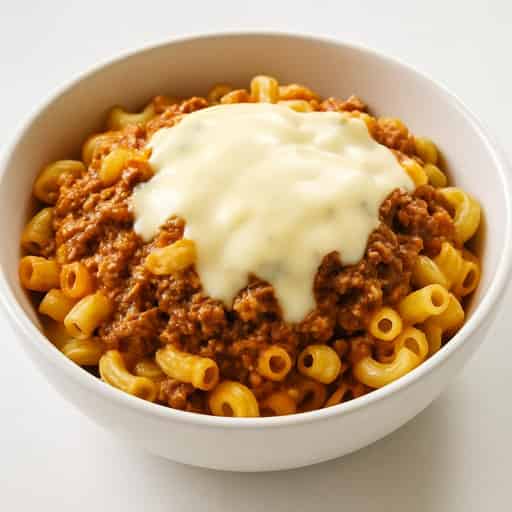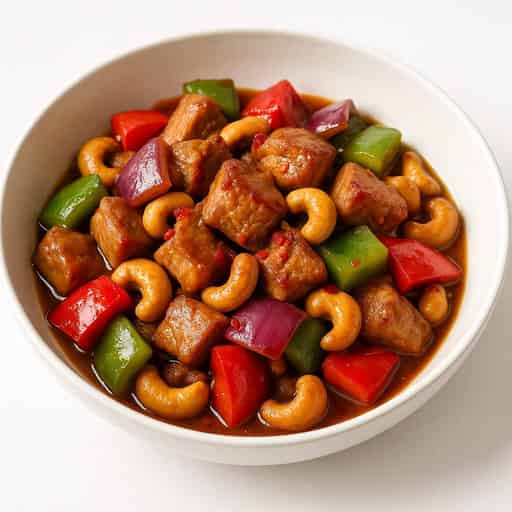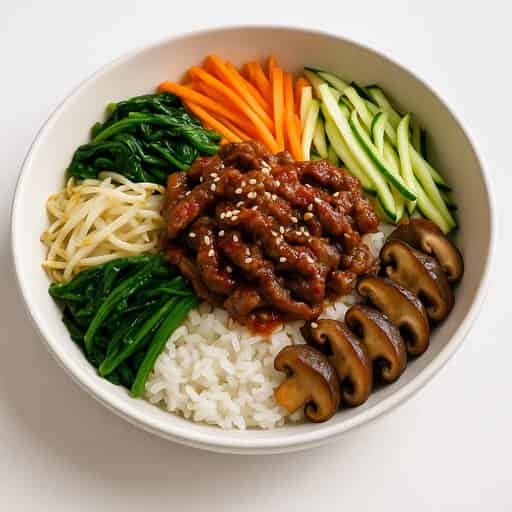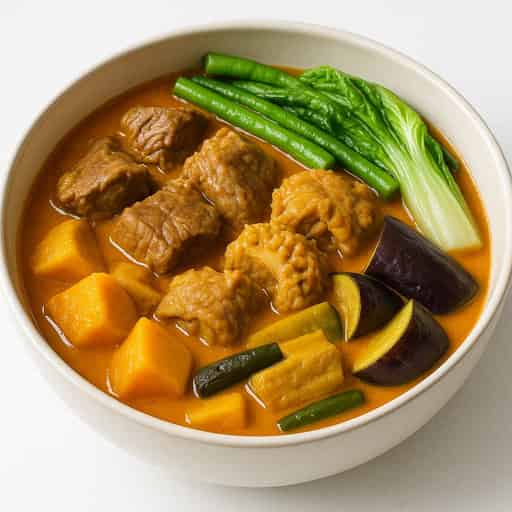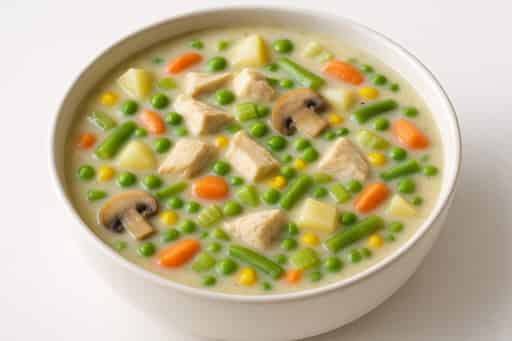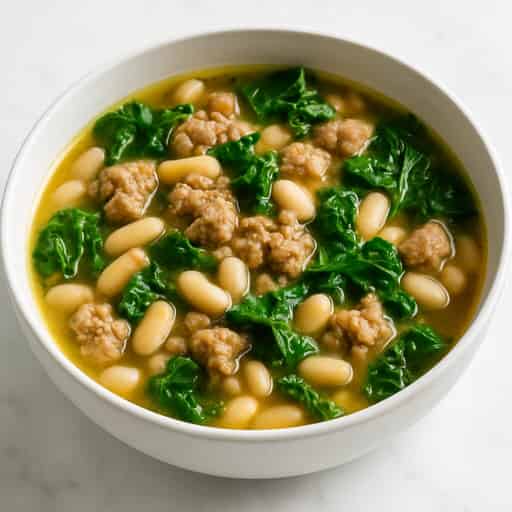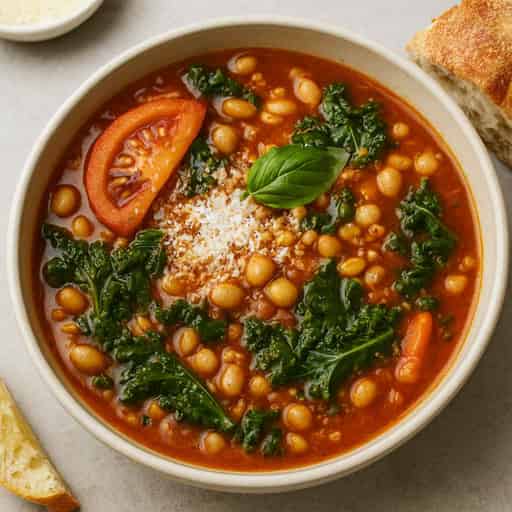Main Course
Pork
Soups And Stews
Quick And Easy
Comfort Food
Comfort Food
High Protein
High Fiber
High Energy
Balanced Meal
Party Food
12 October 2025
Rich & Creamy Filipino Pork Kare-Kare — Authentic Peanut Stew
JojoM

Make this traditional Filipino Pork Kare-Kare with tender pork, creamy peanut sauce, and vibrant vegetables. A comforting stew best served with shrimp paste and steamed rice.
What is Filipino Pork Kare-Kare?
Pork kare-kare is a variation on a Filipino stew made with tender pork chunks, vegetables, and a thick peanut sauce.
It is typically served with rice and some shrimp paste and is a popular dish for special occasions such as fiestas and family gatherings.
The sauce is made from ground peanuts, toasted rice, and other flavorful ingredients such as garlic, onions, and annatto powder.
The vegetables used in the dish include pumpkin, eggplant, long beans, bok choy or Chinese cabbage, and banana blossom.
Ingredients Needed
For the Meat
- 1kg pork shoulder
- some cooking oil
- 5 cloves garlic
- 2 onions, cut in chunks
- 4 pieces bay leaves
- 1 tsp ground black pepper
- 2 tsp tbsp salt
- 1/4 cup vinegar
For the Sauce
- 30g butter
- 30g cooking oil
- 2 tbsp annatto powder
- 1 tbsp shrimp paste
- 5 garlic cloves, crushed
- 2 red onions, chopped
- 1 litre pork stock
- 150g peanut butter
- 1 tbsp fish sauce, to taste
- 4 tbsp rice flour
- 4 tbsp cold water
- 1 tbsp vinegar, to taste
For the Vegetables
- 200g pumpkin, chopped
- 200g eggplant, chunks
- 200g banana blossom, chopped
- 200g Chinese cabbage, whole
- 200g long beans, cut into 2-inch pieces
How to Cook Pork Kare-Kare
Preparing the Meat
- In a saucepan, sear the pork with a bit of cooking oil.
- Add the onions and garlic and saute until fragrant.
- Add the bay leaves, black pepper, salt and vinegar.
- Cover with enough water to submerge the pork pieces and simmer for around 90 minutes or until the pork chunks are tender.
- Set aside the pork chunks and reserve the pork stock.
Making the Peanut Sauce
- In a large sauce pan or Dutch oven, sauté the garlic, onions annatto powder and shrimp paste with the butter and cooking oil.
- Thicken the sauce with some rice flour slurry. Add more as needed.
- Once the onions and garlic are soft and fragrant, add the beef and tripe chunks as well as the hardest vegetables like the pumpkin and continue to simmer.
- Finally, when the pumpkin is slightly cooked, add the remaining vegetables and simmer until all the vegetables are cooked and tender.
Tips for a more Delicious Pork Kare-Kare
- Use high-quality pork with a bit of fat for a more flavorful and tender dish. Also, be sure to boil the pork long enough to make the meat soft and tender.
- If you have time, instead of using peanut butter, you can make your own by first toasting some peanuts then grinding them to a paste. Similarly, you can make your own rice flour by toasting some raw rice then blitzing them to make a fine powder. Toasting the peanuts and rice intensifies their flavours.
- Don't overcook the vegetables to maintain their texture and color. Another option is to simply blanche the vegetables in boiling water to have more control on the cooking process.
- You can add more vegetables such as cabbage, okra, or string beans to the dish to make it even more nutritious.
- You can also adjust the amount of peanut butter and toasted rice powder to your liking. Some prefer a thicker sauce, while others prefer it to be more runny.
Nutritional Breakdown
Given the richness of ingredients, the Filipino Pork Kare Kare is a highly nutritious dish. Here's a detailed breakdown for a serving size of about 300 grams:
- Calories: 600
- Carbohydrates: 40g
- Proteins: 50g
- Fats: 35g
- Sodium: 1400mg
- Cholesterol: 120mg
- Fiber: 6g
Remember, these values can vary slightly based on the exactness of measurements and specific brands used.
Nutritional Benefits of Pork Kare-Kare
Pork kare-kare is not only delicious but also packed with nutrients.
Here are some of the nutritional benefits of this dish:
- Protein: Pork is a good source of protein, which is essential for building and repairing muscles, bones, and other tissues in the body.
- Vitamins and minerals: The vegetables used in pork kare-kare, such as eggplant, long beans, and bok choy, are rich in vitamins and minerals such as vitamin C, vitamin A, and iron.
- Fiber: Vegetables are also a good source of fiber, which can help promote digestive health and prevent constipation.
- Healthy fats: The peanut sauce in beef kare-kare is made from ground peanuts, which are a good source of healthy fats such as monounsaturated and polyunsaturated fats.
While pork kare-kare is a delicious and satisfying dish, it's also relatively high in calories and fat.
However, it does contain some important nutrients, such as protein and iron.
To make the dish a bit healthier, you can use leaner cuts of pork and serve it with brown rice instead of white rice.
Conclusion
In conclusion, pork kare-kare is a delicious and nutritious dish that is perfect for any occasion.
With its savory peanut sauce and tender pork, it is sure to be a hit with your family and friends.
Follow the simple steps outlined in this article to make your own pork kare-kare at home and enjoy its rich flavors and health benefits.
FAQs
-
Can I use chicken instead of pork for kare-kare?
Yes, you can substitute pork with chicken if you prefer.
-
Is pork kare-kare spicy?
No, it is not typically spicy. However, you can add chili flakes or hot sauce if you prefer it to be spicy.
-
Can I make beef kare-kare in advance?
Yes, you can make beef kare-kare in advance and reheat it when ready to serve. The flavors may even deepen and improve after being refrigerated.
-
Can I freeze leftover beef kare-kare?
Yes, you can freeze leftover beef kare-kare for up to 3 months.
-
What are some other traditional Filipino dishes I can try?
Some other popular Filipino dishes include adobo, sinigang, and lechon.
Rich & Creamy Filipino Pork Kare-Kare — Authentic Peanut Stew
JojoMMake this traditional Filipino Pork Kare-Kare with tender pork, creamy peanut sauce, and vibrant vegetables. A comforting stew best served with shrimp paste and steamed rice.

Main Course
Pork
Soups And Stews
Quick And Easy
Comfort Food
Comfort Food
High Protein
High Fiber
High Energy
Balanced Meal
Party Food
Chef's Tips
For extra flavor, toast the rice flour before adding it to the sauce.
Use natural peanut butter for a creamier and more authentic taste.
Add oxtail or tripe along with pork for a richer, festive version.
Garnish with crushed peanuts for a beautiful finish.
Serve with sautéed shrimp paste (bagoong alamang) for the best flavor contrast.
Tools Used
Dutch OvenSaucepan(opens in a new tab)
We use affiliate links, which may earn us a small commission at no extra cost to you.
Ingredients
USMetric
Meat & Base
Aromatics & Seasoning
Sauce
Vegetables
Instructions
Prepare the Pork
- 1
Sear pork shoulder in a bit of oil until browned.
- 2
Add onions and garlic, sauté until fragrant.
- 3
Add bay leaves, pepper, salt, and vinegar.
- 4
Cover with water and simmer for 90 minutes until tender.
- 5
Set pork aside and reserve the broth.
Make the Sauce
- 1
In a separate pan, heat butter and oil.
- 2
Sauté garlic, onions, annatto powder, and shrimp paste until aromatic.
- 3
Add peanut butter and pork stock. Stir to combine.
- 4
Mix rice flour with cold water to form a slurry and add to the sauce.
- 5
Stir in fish sauce and a splash of vinegar.
Combine & Finish
- 1
Add the cooked pork and pumpkin to the sauce and simmer until pumpkin is soft.
- 2
Add eggplant, banana blossom, cabbage, and long beans.
- 3
Simmer just until vegetables are cooked through. Serve hot with shrimp paste and rice.
Comments & Reviews
Eliza G.
6/2/2025
So comforting and flavorful. The sauce was so silky! Toasting the rice flour before mixing in made such a difference.
Ryan T.
5/29/2025
I replaced pork shoulder with pork belly — amazing texture! Added a little more annatto for color and it turned out restaurant-quality.
Bianca L.
3/27/2025
I followed this exactly and it tasted just like my lola’s Kare-Kare! I love the balance of peanut and savory flavors. Definitely saving this for Sunday lunches.
Camille R.
11/26/2024
My first time making kare-kare and it turned out amazing thanks to your detailed instructions. Even my picky eater husband asked for seconds!
Arnold S.
8/25/2024
This brought back so many childhood memories! I served it during a family gathering and it was gone in minutes. Thank you for the step-by-step guidance.
Leah V.
6/24/2024
Loved the flavor but next time I might cut back on the salt a bit. Otherwise, this was perfect with a bowl of warm jasmine rice.
Jake P.
2/23/2024
Solid recipe! I used a pressure cooker to speed up the pork cooking time and it came out super tender. I added more peanut butter for a thicker sauce—yum!
Maria D.
9/22/2023
I made this kare-kare last weekend and my whole family LOVED it! The peanut sauce was rich and flavorful, and the shrimp paste on the side really brought it all together. Will definitely make again.
Save, Plan & Shop Smarter
Create and edit your own recipes, import from most websites, plan your week, and build smart grocery lists.
Import recipes from most websites
Create and edit your own recipes
Plan your week with the Meal Planner
Mark favourites for quick access
Build grocery lists from your meal plan
Tick off pantry items you already have
Nutrition Facts
Serving Size: 1 plate
Calories 600
% Daily Value*
Total Fat 35g45%
Saturated Fat 14g70%
Trans Fat 0g
Cholesterol 120mg40%
Sodium 1400mg61%
Total Carbohydrates 40g15%
Dietary Fiber 6g21%
Sugars 8g
Protein 50g
* Percent Daily Values are based on a 2,000 calorie diet. Your daily values may be higher or lower depending on your calorie needs.
Create your own recipe
Add your personal creations and build your own recipe collection.
Loading...
